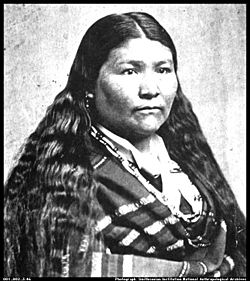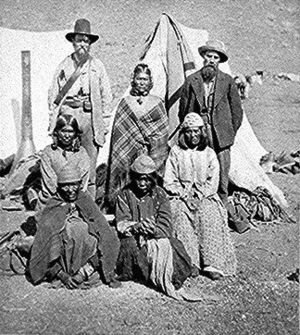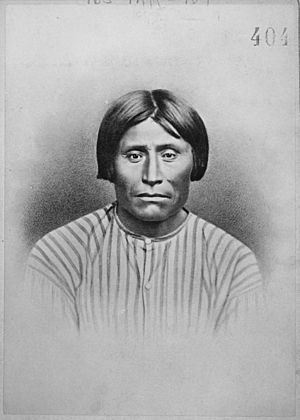Modoc people facts for kids

Toby "Winema" Riddle (Modoc, 1848–1920)
|
|
| Total population | |
|---|---|
| 800 (2000) | |
| Regions with significant populations | |
| 600 | |
| 200 | |
| Languages | |
| English, formerly Modoc | |
| Related ethnic groups | |
| Klamath, Yahooskin | |
The Modoc are a Native American people. They originally lived in what is now northeastern California and central Southern Oregon. Today, Modoc people live in both Oregon and Oklahoma. They are part of two official tribes recognized by the U.S. government. These are the Klamath Tribes in Oregon and the Modoc Nation in Oklahoma.
Contents
Modoc People Today: Where They Live
About 600 Modoc people live in Klamath County, Oregon. This area is near their original homelands. This group includes families who stayed on the reservation during the Modoc War. It also includes descendants of those who returned to Oregon in 1909 from Oklahoma. Many Modoc in Oregon now share a government with the Klamath and Yahooskin tribes. This shared government is called the Klamath Tribes.
About 200 Modoc people live in Oklahoma. They have a small reservation in Ottawa County, Oklahoma. The U.S. government bought this land for them. These Modoc are descendants of the group led by Captain Jack (Kintpuash) during the Modoc War. The U.S. government officially recognized the Modoc Nation in 1978. Their tribal rules were approved in 1991.
Modoc History: A Look Back
Life Before European Contact
Before the 1800s, the Modoc people lived much like other Plateau Indians. They caught salmon when the fish were plentiful. They also moved with the seasons to hunt animals and gather plants for food. In winter, they built special homes called earthen dugout lodges. These homes looked like beehives and were covered with sticks and mud. They built them near lakes where they could find wokas plants and good fishing spots.
Neighboring Native Groups
The Modoc shared their language and the Modoc Plateau with the Klamath people. Other groups living near the Modoc included:
- The Shasta along the Klamath River.
- The Rogue River Athabaskans and Takelma to the west.
- The Northern Paiute to the east in the desert.
- The Karuk and Yurok further down the Klamath River.
- The Achomawi or Pit River people to the south.
The Modoc, Northern Paiute, and Achomawi also shared the Goose Lake Valley.
Modoc Villages
Some known Modoc village sites include:
- Agawesh, near where Willow Creek flows into Lower Klamath Lake. This was home to the Gombatwa·s or Lower Klamath Lake People.
- Kumbat and Pashha on the shores of Tule Lake. These were homes for the Pasganwa·s or Tule Lake People.
- Wachamshwash and Nushalt-Hagak-ni on the Lost River. These belonged to the Goġewa·s or Lower Lost River People.
The Modoc people called themselves Moatokni maklaks. This means "people from the south."
First Encounters with Europeans
In the 1820s, a fur trader named Peter Skene Ogden met the Klamath people. He was an explorer for the Hudson's Bay Company. This was the first time Europeans had regular contact with tribes in the area.
The Applegate Trail Opens
In 1846, brothers Jesse and Lindsay Applegate created a new route called the Applegate Trail. This trail connected the Oregon Trail to the Willamette Valley in western Oregon. It was made to help more European-American settlers move to Oregon. The Applegate brothers were the first known white people in what is now Lava Beds National Monument.
The Applegate Trail brought the first regular contact between the Modoc and the new settlers. Many important events of the Modoc War happened along this trail.
Settlers Arrive in Modoc Lands
From 1846 to 1873, many settlers traveled through Modoc territory. Starting in 1847, the Modoc, led by Old Chief Schonchin, sometimes attacked these groups.
In September 1852, the Modoc attacked a group of settlers at Bloody Point near Tule Lake. Most of the 65 people were killed. A man who survived went to Yreka, California for help. Settlers from Yreka formed a group to bury the dead and seek revenge. This group, led by Ben Wright, later attacked a Modoc band on the Lost River. About 40 Modoc were killed in what became known as the "Ben Wright Massacre."
Historians believe that the Modoc killed at least 300 settlers between 1846 and 1873. It is thought that a similar number of Modoc were killed by settlers and slave traders during this time.
Treaty with the United States Government

In 1864, the United States signed a treaty with the Klamath, Modoc, and Yahooskin tribes. This treaty created the Klamath Reservation. The tribes gave up their lands in exchange for land on the reservation. They also received payments and support from the U.S. government. The treaty said that if the tribes used alcohol, payments could stop. It also allowed other tribes to be moved to the reservation later.
The Modoc, led by Chief Schonchin, moved to the reservation. However, the reservation land did not have enough food for both the Klamath and Modoc people. There was also growing tension between the tribes. The Modoc asked for their own reservation closer to their old home. But neither the U.S. government nor California approved this.
In 1870, a Modoc leader named Kintpuash (also called Captain Jack) led a group of Modoc away from the reservation. They returned to their traditional lands and built a village near the Lost River. These Modoc felt they had not been fairly represented in the treaty. They also wanted to escape problems with the Klamath on the reservation.
The Modoc War

In November 1872, the U.S. Army tried to force Captain Jack's group back to the reservation. A fight broke out, and the Modoc escaped. They went to a strong natural fortress now called Captain Jack's Stronghold in Lava Beds National Monument, California. This small group of fewer than 53 Modoc warriors bravely held off about 3,000 U.S. Army troops for several months. They won several battles against the Army.
In April 1873, the Modoc left the Stronghold and split into smaller groups. Captain Jack and his group were the last to be captured on June 4, 1873. They surrendered because they were told their people would be treated fairly.
In October 1873, Captain Jack and three of his warriors were put on trial. They were found guilty and executed for the death of Major General Edward Canby. Canby had been killed during a meeting. The U.S. Army sent the rest of Captain Jack's group to Oklahoma as prisoners. Scarface Charley became their new chief. The tribe's spiritual leader, Curley Headed Doctor, also had to move to Oklahoma.
Later, in 1909, the Modoc group in Oklahoma was allowed to return to Oregon. Some people did, but most chose to stay in their new home in Oklahoma.
Modoc Culture and Language
The Modoc language and the Klamath language are related. They are part of the Plateau Penutian language family. Both groups called themselves maklaks, which means "people." To tell themselves apart, the Modoc called themselves Moatokni maklaks, meaning "people from the south."
The Modoc people had spiritual practices that are not fully known today. The number five was important in their ceremonies. For example, the Shuyuhalsh was a five-night dance for young girls becoming adults. They also used a sweat lodge for cleansing and for ceremonies after someone died.
Places Named After the Modoc
Many places are named after the Modoc people. These include the Modoc Plateau, Modoc National Forest, and Modoc County, California. There is also a town called Modoc, Indiana.
See also
In Spanish: Modoc para niños



